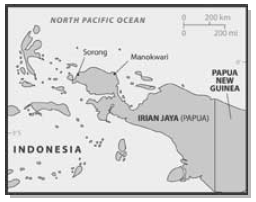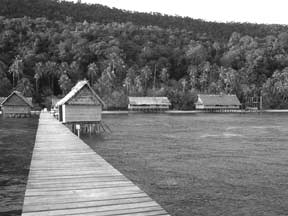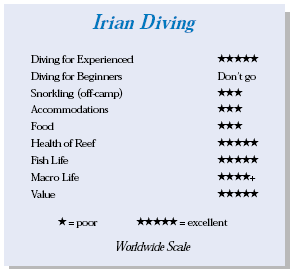Raja Ampat Islands, IndonesiaContents of this Issue: Two Live-Aboard Fatalities Raise Question Editorial Office: Ben Davison Publisher and Editor Undercurrent 3020 Bridgeway, Suite 102 Sausalito, CA 94965 is this the world’s best diving? from the September, 2003 issue of Undercurrent
Dear Fellow Diver: The faint outline of the huge creature was unfamiliar, except for the blunt head. My first thought was pilot whale, but as it emerged from the blue I was watching an 8-foot dugong (Pacific manatee) lumbering along the reef. Sensing my presence, it disappeared with a few powerful flips, transforming itself into a rocketing torpedo. In the Raja Ampats (Four Sultans), even the safety stops served up great sightings like this dugong, or a lethal blue-ringed octopus and banded sea snakes. This was my second trip to the Raja Ampats, where thriving reefs, rare macro life, a profusion of fish, and a setting untouched by time may well boast the world's finest coral reef biodiversity: 450 species of hard corals (half the world's total), 950 species of reef fish (almost twice the number in Paul Humann's Caribbean Reef Fish identification book), and a comparable array of invertebrates. Situated off the coast of Papua (formerly known as Irian Jaya), which shares the island of New Guinea with Papua New Guinea, these are among the more remote islands in Indonesia (it takes two to three days to get there from the U.S.). With only 7,700 inhabitants sprinkled among hundreds of islands, spread over 23,630 square miles, there's little to do except soak up the jaw-dropping beauty of the reefs and islands. Best of all, the price is not prohibitive. With today's low airfares to Asia, you can get there from Los Angeles, sleep, eat, and dive for a week for less than $3,000. The only land-based diving is Irian Diving's Kri Island Camp, operated by owner Max Ammer. Garrulous, with a youthful smile, Max entertains guests with his own adventure stories. He arrived from Holland 12 years ago, became enamored with the undersea beauty, and built a low-impact dive operation. Many of the 20+ dive sites (more are being discovered) are minutes from the pier. At a site called Sardine, a backward roll from one of the two handmade fiberglass dive boats dropped me up-current of the reef corner, but the 2-knot current pushed me past it. Finning furiously and using the lee bommies as rest stops, I fought back to the corner to grab a piece of dead coral at 50 feet and feasted my eyes on schools of tail-fin batfish, bigeye trevally, oriental sweetlips, and yellow stripe barracuda so dense I could barely see other divers just feet away. A 4-foot Napoleon wrasse sauntered by, while dogtooth tuna and mackerel made repeated passes. It was the most fish I'd ever seen in one place, including Palau's Blue Corner. After 15 minutes, the current dropped, and I glided along a slope overflowing with hard and soft corals. They flashed neon reds, oranges, greens, and blues, almost overwhelming the colorful reef fish. When I returned at night during slack tide, macro life thrived. Otto, the guide, spotted three fingernail-sized pygmy seahorses clinging to a pink sea fan, and he found a 2- inch pygmy cuttlefish, its translucent body pulsing color changes. Everywhere I probed, a different nudibranch appeared, including varieties that didn't show up in my fish books. In the morning, after fruit and oatmeal or crepes (eggs upon request), I would grab my gear and jump into a dive boat. They're fast, Spartan, yet functional. There's a small enclosed area for rough seas and rain, but when the boat is full with six to eight divers, there isn't enough room for everybody inside, so rain gear comes in handy (bring your own). Three dives a day was the norm, with night dives on request.
Max's briefings were detailed and accurate. The topography generally consisted of sloping reefs that leveled at 80 to 110 feet, or mini-walls that descended from rock outcroppings. Water temps ranged from the high 70s to the low 80s, with cooler upwellings; visibility was 60 to 80 feet. The weather was hot and humid, but there was usually a nice trade wind. We spent surface intervals at camp for nearby dives, and for day excursions (Kabui Bay, Fam Island, Bantanta Island) a picnic lunch was packed, and we explored the white-sand beaches, where I found Nautilus and other rare shells. Hardly a luxury resort ($145 to $165 per day, depending on length of stay, with food and diving), the camp is full of character and served by a friendly Papuan staff. Otto is a real jokester, and the camp matron, Yolanda, assures that everything runs smoothly. The rest of the staff don't speak English, and, though shy, they were helpful and sang as they went about their day. The camp (capacity is 20 people) straddles a sugary white-sand beach lined with coconut palms and backed by a steep jungle. Parrots, hornbills, and a cassowary (now departed) who loved jumping for bananas, came and went. The rooms and dining area are over the water, so trade winds ease the heat and keep the few bugs at bay. Privacy (sound) is compromised due to the airy design. Rooms are simply furnished with a floor mattress on a woven mat, covered with mosquito netting, plus a table and chairs constructed of local materials like bamboo and palm thatch; cushions on the chairs and recliners would make them more comfortable. Linens were changed every day. Each room has electrical lighting and outlets (220v European) that run off an unobtrusive generator. As for showers, the barrel of sun-warmed water with a scoop was hard to get used to after getting chilled at sea.
Usually, after dinner, people retired to quarters for reading, stargazing, and quiet conversation. The seven guests included Germans, young Brits on an extended Indonesian trip, and a family from Maryland. Sometimes the staff entertained us with homemade instruments and Papuan songs. A day excursion to Kabui Bay offers one of the more unusual dives anywhere. At first it appeared to be a swift river winding through the overhanging jungle, but it was a 60-foot-wide channel connecting the bay to the Halmahera Sea. The flow was the incoming tide. We motored upstream, where I dropped in and was swept into the turbulence, feeling like an underwater kayaker. There were many bends in the channel, so as I eased into the first eddy, I was surprised to see bright-maroon dendronephthya soft coral growing up to the surface. A dazzling assemblage of invertebrates flourished at snorkeling depths, with delicately sculpted transparent tunicates, vibrant encrusting sponges, and spidery crinoids displaying a rainbow of colors in water no deeper than 25 feet. As I eddy-hopped downstream, each bend became a new dive site. Regal lionfish peeked out from coral fortresses, and the day-glo pink and lime-green colors of neon sea slugs were straight from a 1960s black-light poster. Angelfish, clown triggers, and ornate butterflyfish glided in and out of the hard corals, and a school of Moorish idols zigzagged in the current. Otto told me to search for archerfish, which position themselves under jungle branches, ready to gun down unsuspecting insects with their well-aimed stream of spit. Sharks and Napoleon wrasse use the passage as a quick entry and exit into Kabui Bay, and I spotted a 6-foot whitetip heading upcurrent, as well as a herd of 12 humphead parrotfish searching for their next coral-grazing feast. Further downstream, I came upon a 7-foot wobbegone shark under a coral ledge, reminding me of an overfed toadfish. The dive ended with several narrow entrances to caverns that penetrated the rocky shoreline. During our surface interval we
meandered through the upper reaches of
Kabui Bay, negotiating narrow waterways
between strangely shaped limestone for mations that rivaled the Rock Islands
of Palau. In a large amphitheater of
jungle-draped cliffs, a pod of six
dolphins silently plied the waters for
fish. I saw Tridacna clams the size of a small bathtub near Wai Island and monster Queensland groupers and leaf scorpionfish on Cape Kri. Large mature hawksbill and green turtles were everywhere. The bright-green table corals of Fam Island were big enough to seat a family of 10 for dinner. Throw in a collection of World War II airplane wrecks, and I never had a mediocre dive on any of the standard dive sites. After diving Wakatobi, a good portion of Sulawesi, Bali, and Alor, this is surely some of Indonesia's finest diving. So what's the downside? Pelagics and large fish (sharks, tuna, Napoleons) have taken a significant hit, though when the current was right, individuals and small schools still made an appearance at some locations. The underwater topography on the standard sites, with some exceptions (e.g., The Passage), was not particularly unique nor dramatic. Illegal fishing is slowly on the rise and will continue to threaten the Raja Ampats until locals are given adequate incentives to protect their reefs. And there is no diving on Saturday, the Sabbath: Max and many staff are Seventh-Day Adventists. Irian Diving offers multi-day exploratory trips to the Wayag group, limestone islands fronted by 100-meter cliffs that plunge directly into the sea. The tranquil inner lagoon holds hidden passages and secret inlets, some leading to sea caves, spectacular rock arches, and secluded turtle-nesting beaches. For sheer beauty, Wayag is the gem of the Raja Ampats. We did five days of diving in the area and found everything from five-star reefs, teeming with fish and invertebrate life, to a few mediocre sites that wouldn't warrant repeats (that's what you get when you explore). Max brings a cook, boat crew, and compressor. There are no accommodations, but we camped in the most dramatic and serene tropical setting imaginable. Ammer's Going Upscale: Just as we were ready to go to print, we e-mailed Ammer to see if there had been changes since our incognito reviewer visited. Ammer said that he sold Irian Diving to Papua Diving, a four-person Dutch Company that includes Ammer. The existing resort will get two new boats and will add unlimited fresh water, toilets, and showers. Out of sight of the eco resort, they are constructing a small upscale resort, which will have nine bungalows with bathrooms and air conditioning. He says they will have three boats for six divers each, a large photographers' facility, a restaurant with menus choices and view over the lagoon, telephone and Internet facilities, and a research center. They hope to be able to handle six guests in the new quarters as early as January. -- M.O. * * * * * Indonesian live-aboards travel to the Raja Ampats from September through February. One of our Undercurrent correspondents on his way to Camp Kri got sidelined during the camp's brief closure, but Ammer substituted a trip on the locally based live-aboard,Shakti. Here is his report: The Shakti is a 33-meter, twin-masted motor sailer capable of cruising 12.5 knots. She is an Indonesian-built "pinisi," a local design with generations of history. With three triple cabins, one double, and two singles, the Shakti can hold 13 guests. The "triples" are a bit of a stretch, so she more comfortably accommodates 10. The single cabins are on the main deck and are reached through the dining room. The four larger cabins are below decks, with a spacious area dubbed "the lounge," with padded benches and a TV, which was used primarily as a work space for photographers. The dining room served as the lounge. All cabins are air conditioned but do not have individual controls. Mine had an A/C problem, rendering it unbearably hot and stuffy. I usually slept on the cushions in the lounge or sundeck when rain wasn't threatening. Air ranged from the 90s during the day to the mid to high 70s at night. Because there are no en suite bathrooms, I had to climb up from below decks to a bathroom on either the port or starboard side. Only one has a fresh water shower. The second is used primarily by the crew. Guests shared a single bathroom. The shower had warm water only when the boat was underway and the generators had been running. When I arrived in Sorong, the two Shakti dive boats, an inflatable and a 13- foot fiberglass skiff, ferried us from the airport dock to where the Shakti was moored, a five-minute trip. The boat isn't up to luxury live-aboard standards, but it served just fine, thanks to the two English divemasters, Andrew and Cherry, who were affable hosts and knocked themselves out to give us good diving. Both skiff operators took great care in handling the cameras, and the crew did their respective jobs well and with good humor. The aluminum 80 tanks were consistently filled to 3,000 psi. I dived from either of the two small boats, which was something of a challenge since they had no ladders and I had to pull myself in over the side. I set up my tank before each dive, and the crew stored it behind the bench seats of the dive boats and toted it back to the Shakti after each dive. Although buddy diving wasn't enforced, we stayed mostly together. No time or depth limits were imposed; however, I never had a reason to dive below 130 feet. Dives ended when divers got low enough on air to have to surface. Most of my dives ran 60 to 75 minutes. The choice of sites, the drop-in points, the time of the day dives, the visibility, and indeed the entire itinerary was dictated by the tides and currents. Andrew and Cherry scheduled the dives around slack tide, but that was not always feasible.
Our first dive was a leisurely drift along Fam Wall, encrusted with soft corals, abundant nudibranchs, and gorgonians with pigmy seahorses -- a dream dive for macro photographers. Our second dive was one of those hang-on-to-your-hat-andwatch- the-blur-of-the-wall-as-it-whizzes-by dives. Upon entry, instructions like "keep the wall on the right" often changed to "wall on the left." While a few dives were suitable for only very experienced divers, the unpredictability made the dives more exciting, and the currents certainly produced more fish action. During the 10-day March cruise, we dived 16 very different dive sites, most "world class." The undisputed favorite was Melissa's Garden, discovered by Max and named after his daughter. The maximum depth was 60 feet, but I went no deeper than 30 feet. The site explodes with color from the profusion of soft corals, anemones, tunicates, hydroids, etc. We seven well-traveled divers agreed we had never seen hard corals anywhere in the world like those at Melissa's Garden. There were vast fields of elkhorn, staghorn, finger, boulder star, great star, and lettuce coral. Brain coral was monstrous. What looked like large bommies at a distance would turn out to be mammoth sponges. The site teemed with reef fish, eels, giant clams, and nudibranchs. And it served up less common surprises such as large banded sea kraits, some hitting the 6-foot mark. The Shakti does not offer Nitrox and has no rental gear, although the crew did lend a mask when one diver's broke. They also performed minor repairs, but bring a good save-a-dive kit. I averaged three dives per day. Night dives were available most nights, conditions permitting. Meals were tasty, wholesome, varied, and plentiful. There was always fresh fish caught by the crew, Indonesian dishes, and a nice mix of Western food, pasta dishes, and plenty of fresh fruits and vegetables. We even had a couple of surprises like fresh, made-from-scratch flour tortillas and delicious breadfruit chips. The two cooks, Octofina and Henny, are workhorses who never stopped. All beverages were an extra charge on the honor system. The beer supply dried up late in the trip; there was no wine or hard liquor. My fellow passengers and I spent our evenings watching videos from this trip and past trips, filling in dive logs, perusing fish ID books, listening to the crew sing, stargazing, working on cameras, listening to newscasts on the short wave radio, and getting to know each other. Though providing superb service, Andrew and Cherry asked us not to tip them. They considered themselves well compensated. Instead they suggested that all tips should go to the local crew as a whole, the less visible members of the crew who were equally responsible for providing good service and a good trip. We all agreed to put $100 each, generous by local standards, into the common tip pot. In hindsight, being switched to the Shakti was quite fortunate. I experienced the better sites dived by Irian Divers, as well as some sites seen by precious few divers, which lent a sense of adventure and exploration to the trip. And the diving was, in a word, remarkable. -- I.I.
|
||||||||

I want to get all the stories! Tell me how I can become an Undercurrent Online Member and get online access to all the articles of Undercurrent as well as thousands of first hand reports on dive operations world-wide
| Home | Online Members Area | My Account |
Login
|
Join
|
| Travel Index |
Dive Resort & Liveaboard Reviews
|
Featured Reports
|
Recent
Issues
|
Back Issues
|
|
Dive Gear
Index
|
Health/Safety Index
|
Environment & Misc.
Index
|
Seasonal Planner
|
Blogs
|
Free Articles
|
Book Picks
|
News
|
|
Special Offers
|
RSS
|
FAQ
|
About Us
|
Contact Us
|
Links
|
3020 Bridgeway, Ste 102, Sausalito, Ca 94965
All rights reserved.

 Following a low-key checkout dive with
Max, I was free to dive my own profile without
restriction on decompression dives, even
though the chamber in Mandano requires an
airlift from Sorong with a connection in
Ujung Pandang. They asked us to stick to
pre-stated bottom times due to the strong
tide-dependent currents (we experienced downward
currents twice). Slower-paced dives
were possible at slack tide or in protected
lagoons.
Following a low-key checkout dive with
Max, I was free to dive my own profile without
restriction on decompression dives, even
though the chamber in Mandano requires an
airlift from Sorong with a connection in
Ujung Pandang. They asked us to stick to
pre-stated bottom times due to the strong
tide-dependent currents (we experienced downward
currents twice). Slower-paced dives
were possible at slack tide or in protected
lagoons.  They serve dinner and lunch familystyle
-- fish (sometimes chicken and
beef), in Indonesian sauces (some
spicy), with rice or yams. Vegetables
ranged from a spinach-like fern that
grows in the nearby jungle to eggplant
and cabbage. Fruits included mango,
bananas, papaya, and watermelon.
Yolanda and her kitchen crew prepared
meals and pre-dinner snacks (request the
banana fritters!) in a kerosene wok in
the open-air dining area, which made
for a good cooking show. Dinners were
tasty, hearty, and nutritious, though I
craved good old American cooking by the
end of my stay. Beverages included
different syrups for flavoring the warm water. Slightly cool beer was kept in a cooler with the perishables. Bring your
own booze and extra beer if you want more than a couple a day.
They serve dinner and lunch familystyle
-- fish (sometimes chicken and
beef), in Indonesian sauces (some
spicy), with rice or yams. Vegetables
ranged from a spinach-like fern that
grows in the nearby jungle to eggplant
and cabbage. Fruits included mango,
bananas, papaya, and watermelon.
Yolanda and her kitchen crew prepared
meals and pre-dinner snacks (request the
banana fritters!) in a kerosene wok in
the open-air dining area, which made
for a good cooking show. Dinners were
tasty, hearty, and nutritious, though I
craved good old American cooking by the
end of my stay. Beverages included
different syrups for flavoring the warm water. Slightly cool beer was kept in a cooler with the perishables. Bring your
own booze and extra beer if you want more than a couple a day. Further along, Otto pointed to
a tiny ledge 10 feet above the water
line. There sat four human skulls,
peering across the water. Nearby, we
saw a cave where several bed frames
held a collection of human skulls and
bones, a ransacked Papuan burial site
from the early 1900s. We visited a
larger cave where thousands of bats
roosted.
Further along, Otto pointed to
a tiny ledge 10 feet above the water
line. There sat four human skulls,
peering across the water. Nearby, we
saw a cave where several bed frames
held a collection of human skulls and
bones, a ransacked Papuan burial site
from the early 1900s. We visited a
larger cave where thousands of bats
roosted. Diver's Compass: A one-week package at Camp Kri (three daily
dives, meals, accommodations, boat transfer from airport near
Sorong) runs $1,055. ... With longer stays, and for repeat guests,
the price comes down. ... You can enter Indonesia via Jakarta,
through Ujung Pandang (Makassar), Bali, or Manado (northern
Sulawesi). ... These islands are far removed from the scattered
radical Islamic activity in Indonesia. ... I flew to Jakarta
($800 to $1,000 from Denver on Singapore Air), overnighted at
the Quality Motel ($75), which is conveniently in the terminal just outside customs,
then flew to Sorong on the 5 a.m. Pelita Air flight ($500). ... I arrived
in Sorong at 1 p.m. to catch a prearranged two-hour transport to Camp Kri in one
of Max's boats -- great views of surrounding mountainous islands, but can be bonejarring
in rough conditions. ... Watch the weight limit on Pelita (20 kg, $3 per
extra kg); pack heavy items in your carry-on. ... Irian Diving (
Diver's Compass: A one-week package at Camp Kri (three daily
dives, meals, accommodations, boat transfer from airport near
Sorong) runs $1,055. ... With longer stays, and for repeat guests,
the price comes down. ... You can enter Indonesia via Jakarta,
through Ujung Pandang (Makassar), Bali, or Manado (northern
Sulawesi). ... These islands are far removed from the scattered
radical Islamic activity in Indonesia. ... I flew to Jakarta
($800 to $1,000 from Denver on Singapore Air), overnighted at
the Quality Motel ($75), which is conveniently in the terminal just outside customs,
then flew to Sorong on the 5 a.m. Pelita Air flight ($500). ... I arrived
in Sorong at 1 p.m. to catch a prearranged two-hour transport to Camp Kri in one
of Max's boats -- great views of surrounding mountainous islands, but can be bonejarring
in rough conditions. ... Watch the weight limit on Pelita (20 kg, $3 per
extra kg); pack heavy items in your carry-on. ... Irian Diving (